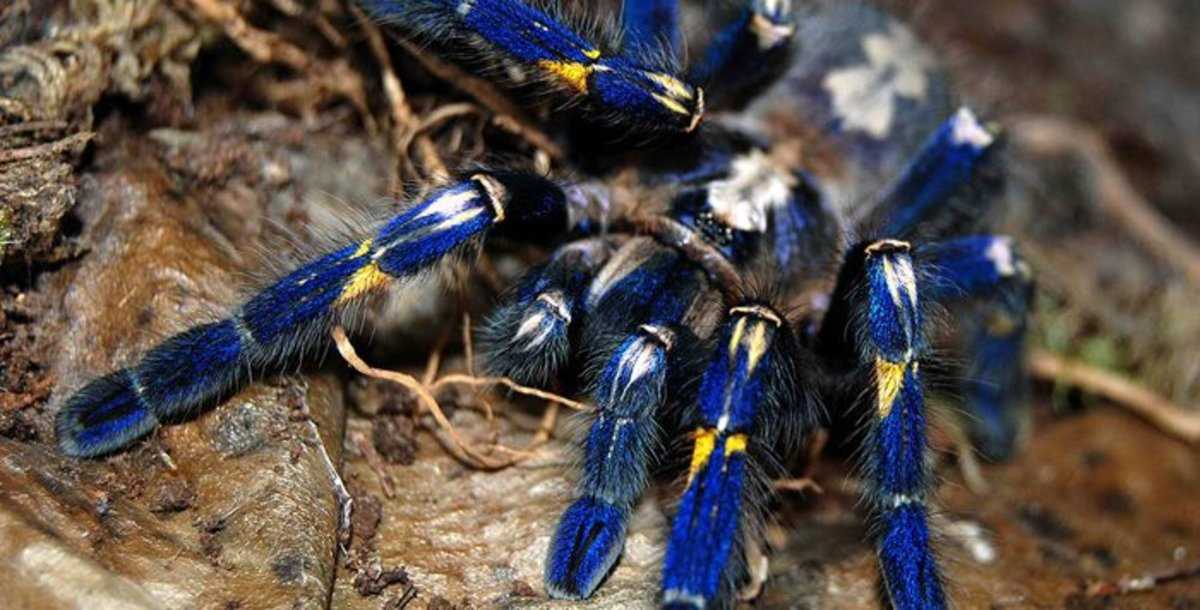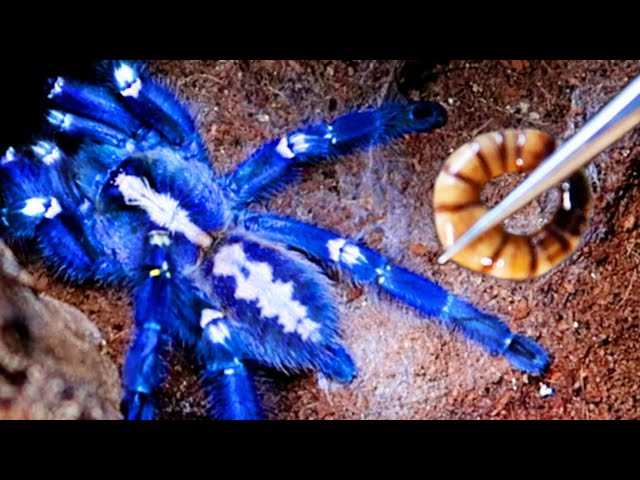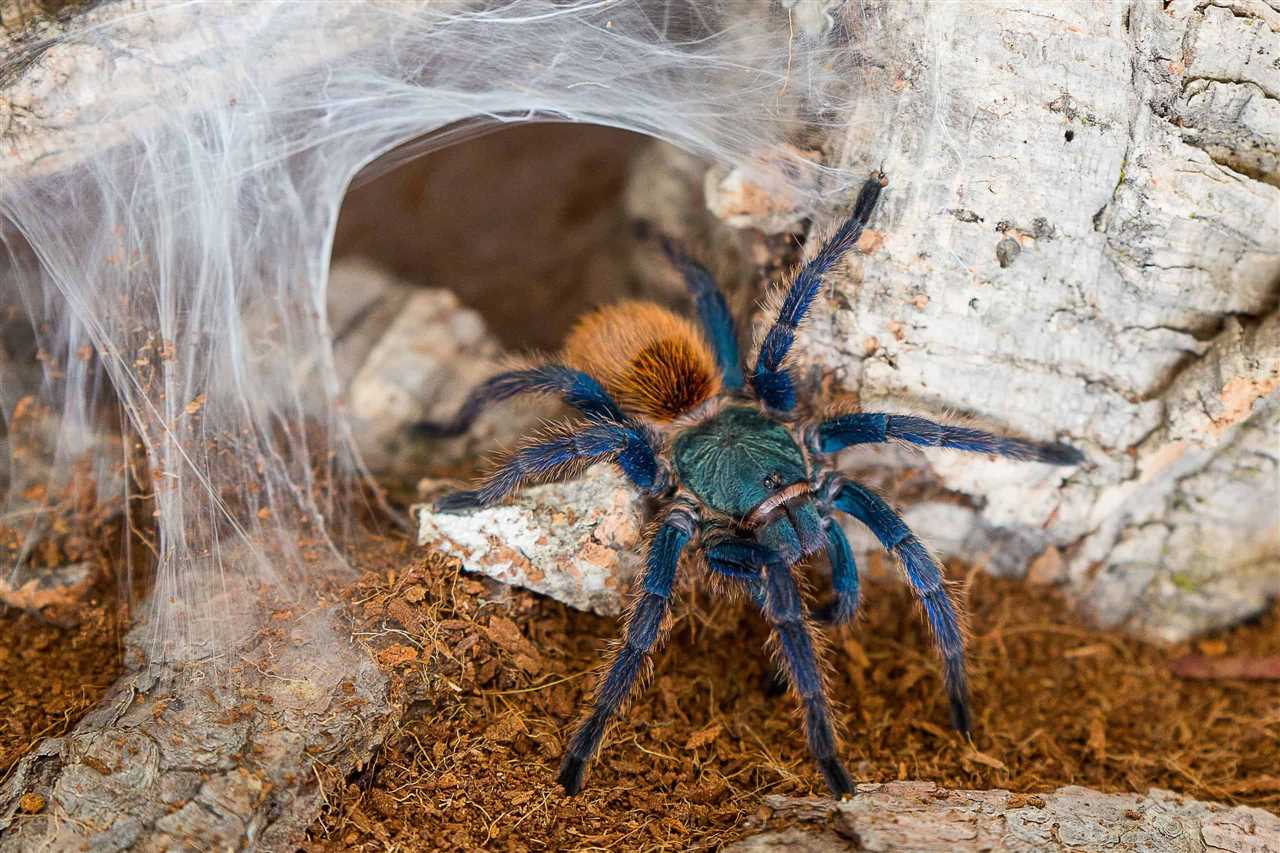
The Blue Chilean Rose Tarantula is native to the desert regions of Chile, where it resides in burrows it creates in the ground. Despite its name, the Blue Chilean Rose Tarantula is not actually blue. Rather, it has a dark brown to black base color, with a striking blue sheen that is most visible in certain lighting conditions. This blue coloration is caused by microscopic hairs on the surface of their exoskeleton that scatter and reflect light.
Overall, the Blue Chilean Rose Tarantula is a captivating arachnid that can make a great pet for those with an interest in invertebrates. By providing the proper care and habitat, enthusiasts can enjoy the beauty and unique behaviors of this stunning spider.
Blue Chilean Rose Tarantula Care
Enclosure Setup
Place a layer of substrate, such as peat moss or coconut fiber, at the bottom of the enclosure, providing a depth of at least two inches. This substrate will help maintain the tarantula’s desired humidity levels and provide a suitable surface for burrowing.
Temperature and Humidity Requirements
Nutrition and Feeding

Offering food once or twice a week should be sufficient for the tarantula’s nutritional needs. Make sure to remove any uneaten prey within 24 hours to prevent it from causing harm or stress to your pet.
Handling and Taming
With patience and time, you may be able to tame your tarantula and build trust, but it is essential to prioritize its well-being and comfort above all.
Proper Enclosure Setup for the Blue Chilean Rose Tarantula
The size of the enclosure should be appropriate for the size of your tarantula. A general rule of thumb is to provide at least three times the leg span in floor space. This allows the spider to move around comfortably and exhibit natural behaviors.
- Substrate: The substrate in the enclosure should be kept dry, as Blue Chilean Rose Tarantulas prefer a drier environment. Coconut fiber or a mixture of peat moss and vermiculite can be used as substrate.
- Hideouts: Providing hiding spots in the enclosure is essential for the tarantula’s well-being. You can use cork bark, small logs, or artificial hiding places to create hiding spots for your spider.
- Furnishings: Adding some decorations and furnishings to the enclosure can make it more visually appealing and provide enrichment for your tarantula. You can include artificial plants, branches, or small rocks.
By following these guidelines for proper enclosure setup, you can provide a suitable and comfortable habitat for your Blue Chilean Rose Tarantula, making it a happy and healthy pet.
Temperature and Humidity Requirements

Temperature:
Humidity:
Maintaining the correct humidity levels is essential for the Blue Chilean Rose Tarantula, as it mimics their natural habitat in the Chilean desert. The recommended humidity range is between 60% and 70%. To achieve this, you can mist the enclosure with water regularly or provide a shallow water dish for your tarantula to drink from. Additionally, placing a hygrometer in the enclosure will help you monitor the humidity levels accurately.
It is crucial to strike a balance between temperature and humidity to prevent any adverse effects on your Blue Chilean Rose Tarantula’s health. A dry environment can lead to dehydration and difficulty molting, while excessive moisture can promote the growth of harmful bacteria and fungi. Regular monitoring and adjustments will ensure that your tarantula thrives in its habitat.
| Temperature: | Humidity: |
|---|---|
| 75°F (24°C) to 85°F (29°C) | 60% to 70% |
Nutrition and Feeding
The main staple of a Blue Chilean Rose Tarantula’s diet should be live insects, such as crickets, cockroaches, mealworms, and locusts. These can be easily purchased from pet stores or bred at home for convenience. It’s essential to ensure that these prey items are gut-loaded before feeding them to your tarantula. This means that they should be fed a nutritious diet themselves before becoming meals for your spider.
In summary, providing a proper diet is essential for the well-being of your Blue Chilean Rose Tarantula. Offering a variety of live insects and occasional small vertebrates will help ensure that your pet spider receives the necessary nutrients for growth and overall health.
Handling and Taming the Blue Chilean Rose Tarantula
Before attempting to handle your tarantula, it is crucial to establish a bond and gain their trust. Spend time observing and interacting with your tarantula from outside their enclosure. This will help them become familiar with your presence and associate it with positive experiences, such as feeding or cleaning.
When handling your tarantula, it is advisable to wear gloves to protect both yourself and the spider. Use a soft, flat surface, such as a clean table or countertop, to provide a controlled environment for the interaction. Make sure the area is free from any potential hazards or escape routes.
To minimize stress for your tarantula, approach them gently and avoid sudden movements. Slowly and carefully place your hand or glove in front of the tarantula, allowing them to crawl onto it at their own pace. Never force the tarantula to walk onto your hand or hold them tightly.
While handling, it is crucial to support the tarantula’s entire body to prevent any accidental falls or injuries. Keep your movements steady and avoid any sudden jolts or vibrations that may startle the spider.
Common Health Issues of the Blue Chilean Rose Tarantula
1. Mites and Parasites
One common health issue for blue Chilean rose tarantulas is the presence of mites and parasites. These tiny creatures can infest the tarantula’s body and cause irritation, loss of appetite, and general discomfort. Regularly inspecting your tarantula for signs of mites or parasites is crucial to ensure its well-being.
2. Respiratory Infections
3. Injuries from Falls
Injuries from falls can also be a concern for blue Chilean rose tarantulas. Tarantulas are climbers and can sometimes fall while attempting to navigate their enclosure. A fall from a high spot can cause serious injuries, such as a ruptured abdomen or damaged limbs. Providing plenty of secure climbing structures in the enclosure can help prevent these accidents.
4. Molting Complications
Molting is a natural process for tarantulas, where they shed their old exoskeleton to grow. However, molting complications can occur, especially if the tarantula is not properly hydrated or if the humidity levels are not appropriate. These complications can lead to issues such as stuck molts or incomplete molts, which can be life-threatening for the tarantula.
5. Allergic Reactions
Although rare, some individuals may develop allergic reactions to their blue Chilean rose tarantula. Allergies can manifest as skin rashes, difficulty breathing, or other allergic symptoms. It is essential to be aware of any potential allergies and seek medical attention if necessary.
To ensure the health and well-being of your blue Chilean rose tarantula, it is crucial to provide proper care, monitor their behavior closely, and seek veterinary assistance if any health concerns arise. By being proactive and attentive, you can help your pet spider live a long and healthy life.
Blue Chilean Rose Tarantula Habitat
Temperature and humidity levels are crucial for the well-being of your tarantula. The ideal temperature range is between 75-85°F (24-29°C), with a slight drop in temperature during the nighttime. To achieve the recommended humidity levels of 65-75%, mist the enclosure with water regularly and provide a shallow water dish for drinking.
Blue Chilean Rose Tarantulas are generally hardy creatures, but there are some common health issues to be aware of. These may include mites, fungal infections, and bacterial infections. Regular monitoring and proper care can help prevent these issues.
In their natural habitat, Blue Chilean Rose Tarantulas inhabit dry, scrubland regions of Chile. To mimic their natural environment, provide a substrate of a mixture of peat moss and vermiculite. Additionally, decorate the enclosure with hiding spots, such as cork bark or artificial plants, to provide a sense of security for your tarantula.
The Natural Habitat of the Blue Chilean Rose Tarantula
In its natural habitat, the Blue Chilean Rose Tarantula can be found in the northern provinces of Chile, specifically around the Atacama Desert and the surrounding coastal regions. These areas are characterized by arid and semi-arid climates, with minimal rainfall and extreme temperature fluctuations.
These tarantulas prefer to make their homes in burrows, which they create by excavating the soft soil found in their natural environment. These burrows serve as shelter and protection from predators, as well as a place for the tarantula to rest and molt.
Due to the desert-like conditions of its habitat, the Blue Chilean Rose Tarantula has evolved to be able to withstand high temperatures and prolonged periods of drought. They have adapted to conserve water by sealing their burrows and minimizing water loss through their exoskeleton.
Enclosure Decoration for the Blue Chilean Rose Tarantula
| Substrate: | Start by providing a suitable substrate at the bottom of the enclosure. The Blue Chilean Rose Tarantula prefers a substrate that is moist but not waterlogged. A mixture of peat moss and vermiculite works well for maintaining the right moisture levels. This substrate also helps to maintain humidity within the enclosure. |
| Hiding spots: | |
| Climbing opportunities: | |
| Moisture source: | The Blue Chilean Rose Tarantula requires a slightly higher humidity level than other tarantula species. To achieve this, you can provide a moisture source such as a shallow water dish or a moss-filled hide. This will help to maintain a suitable humidity level within the enclosure and promote healthy molting. |
| Decorative elements: | In addition to the basic enclosure setup, you can add some decorative elements to enhance the visual appeal of the habitat. You can include artificial plants, fake leaves, or even small rocks or pebbles to create a more aesthetically pleasing environment. However, make sure that these decorations are safe for your tarantula and won’t pose any risk or harm. |
Remember, creating a suitable enclosure decoration for your Blue Chilean Rose Tarantula is essential for its overall well-being and happiness. By recreating its natural habitat, you can provide a stimulating and comfortable environment for your exotic pet.
Creating the Ideal Habitat for an Exotic Blue Chilean Rose Tarantula
When setting up the enclosure for your Blue Chilean Rose Tarantula, there are several key factors to consider. Firstly, the size of the enclosure should be appropriate for the size of the spider. A tank that is at least three times the leg span of the tarantula is recommended to provide ample space for it to move around and create its web.
The substrate, or bedding, should be a mixture of peat moss, vermiculite, and coconut fiber to create a moist and humid environment. This helps to replicate the natural habitat of the tarantula, which is typically found in damp forest areas.
In addition to the substrate, providing hiding spots for your Blue Chilean Rose Tarantula is essential. This can be done by placing various objects such as hollowed-out logs, cork bark, or artificial plants in the enclosure. These hiding spots not only provide a sense of security for the tarantula but also add visual interest to the habitat.
Temperature and humidity are crucial factors in maintaining the health and well-being of your tarantula. The ideal temperature range for a Blue Chilean Rose Tarantula is between 70-85°F (21-29°C), with a humidity level of around 75-85%. To achieve the appropriate temperature and humidity, you can use a combination of heat mats, thermostats, and misting systems.
- Regularly monitor the temperature and humidity levels using a digital thermometer and hygrometer
- Mist the enclosure with water once or twice a week to maintain the desired humidity level
Blue Chilean Rose Tarantula Traits
One of the most striking features of the Blue Chilean Rose Tarantula is its blue coloration, which sets it apart from other tarantula species. The vibrant blue hue can range from a deep blue to a lighter aquamarine shade, making it a truly unique and eye-catching spider.
In addition to its stunning appearance, the Blue Chilean Rose Tarantula is known for its docile and calm temperament. Unlike some other tarantula species that can be aggressive or defensive, this tarantula is generally tolerant of handling and is considered one of the more gentle pet spiders.
Another interesting trait of this tarantula is its ability to create silk webs. While not all tarantula species are adept at web-building, the Blue Chilean Rose Tarantula is known to construct intricate webs in its enclosure. These webs serve multiple purposes, including creating a retreat and catching prey.
Physical Characteristics
The Blue Chilean Rose Tarantula has a medium-sized body covered in dense, velvety hair. Its legs are long and hairy, aiding in its movement and capturing prey. The spider has a stocky build, with a broad abdomen that houses its vital organs.
While the spider’s main claim to fame is its blue coloration, it should be noted that young individuals may not display this hue until they mature. Juvenile Blue Chilean Rose Tarantulas often exhibit a more subdued coloration, with hints of blue that become more pronounced with age.
Furthermore, like other tarantula species, the Blue Chilean Rose Tarantula has multiple pairs of eyes positioned on the front of its cephalothorax. These eyes grant it excellent vision and help it detect prey and potential threats in its surroundings.
Physical Characteristics of the Blue Chilean Rose Tarantula
The Blue Chilean Rose Tarantula is a fascinating and exotic pet spider that is highly sought after by arachnid enthusiasts. With its vibrant blue coloration and unique traits, it has become a popular choice for those looking to keep an eye-catching and distinctive tarantula.
One of the most striking features of the Blue Chilean Rose Tarantula is its color. Unlike other tarantula species, which are typically brown or black, the Blue Chilean Rose Tarantula has a vibrant blue hue that sets it apart. This brilliant coloration is due to the presence of microscopic structures on its hair, which reflect and refract light to produce a blue appearance.
In addition to its stunning blue color, the Blue Chilean Rose Tarantula has a robust and stocky body. It has eight legs, each equipped with sharp claws that enable it to climb and grip onto various surfaces. It also has fangs located at the front of its head, which it uses to inject venom into its prey, helping it to immobilize and consume its meals.
Another notable physical characteristic of the Blue Chilean Rose Tarantula is its size. Adult females can reach a leg span of up to 5 inches, making them quite large compared to other tarantula species. Males, on the other hand, tend to be smaller and have a leg span of around 3-4 inches.
Overall, the Blue Chilean Rose Tarantula exhibits a combination of unique and fascinating physical characteristics that make it a captivating pet for spider enthusiasts. Its vibrant blue color, robust body, and distinct features set it apart from other tarantula species and make it a truly remarkable arachnid to behold.
Blue Chilean Rose Tarantula Traits
The Blue Chilean Rose Tarantula is a fascinating invertebrate that has gained popularity as a pet in recent years. This exotic arachnid is known for its striking blue coloration, making it a unique and eye-catching addition to any collection of spiders.
One of the most distinguishing physical characteristics of the Blue Chilean Rose Tarantula is its vibrant blue body. This stunning coloration sets it apart from other tarantulas and gives it a truly mesmerizing appearance. The blue color is caused by a combination of pigments in the spider’s exoskeleton, giving it a shimmering and metallic sheen.
Another interesting trait of the Blue Chilean Rose Tarantula is its ability to spin webs. While many people associate spiders with building intricate webs, tarantulas are actually not known for their web-building skills. Instead, they use their silk to line their burrows and create retreats where they can hide and feel safe. This behavior is especially important in their natural habitat, where they may encounter predators and harsh weather conditions.
Overall, the Blue Chilean Rose Tarantula is a fascinating and unique pet that requires specific care and attention. Its stunning blue color, docile temperament, and interesting web-building behavior make it a captivating addition to any tarantula enthusiast’s collection.

I’m Lena Adams—a product of an unconventional upbringing in the African wilderness. My father, a daring explorer of African wildlife, sparked my fascination with reptiles, a passion that intertwined with the tragic loss of my mother during an expedition, leaving an indelible mark on my life. Driven to understand the creatures that captivated my parents, I embarked on my journey, sharing insights about reptiles, frogs, and lizards on my website. Through my explorations and conservation efforts, I honour my family’s legacy while seeking connections—to the creatures, nature, and the mother whose presence I yearn to understand.
